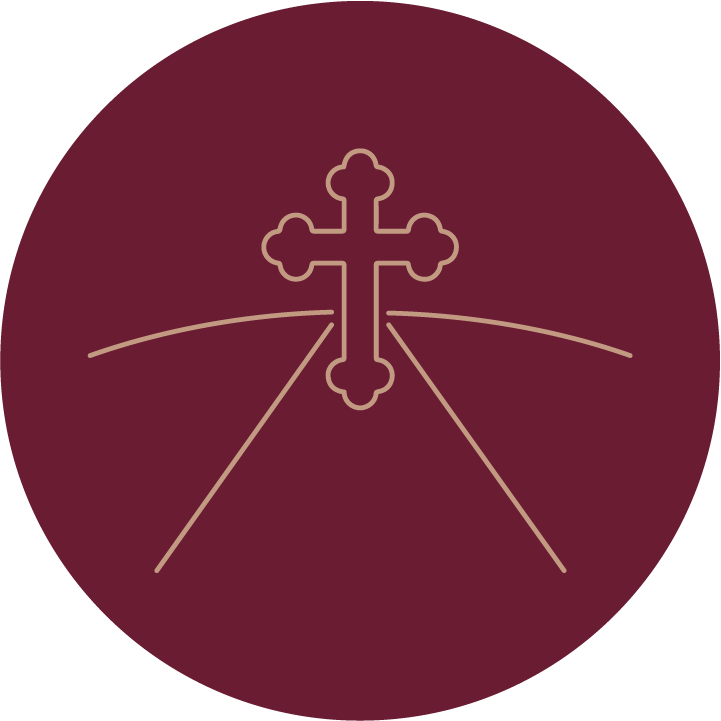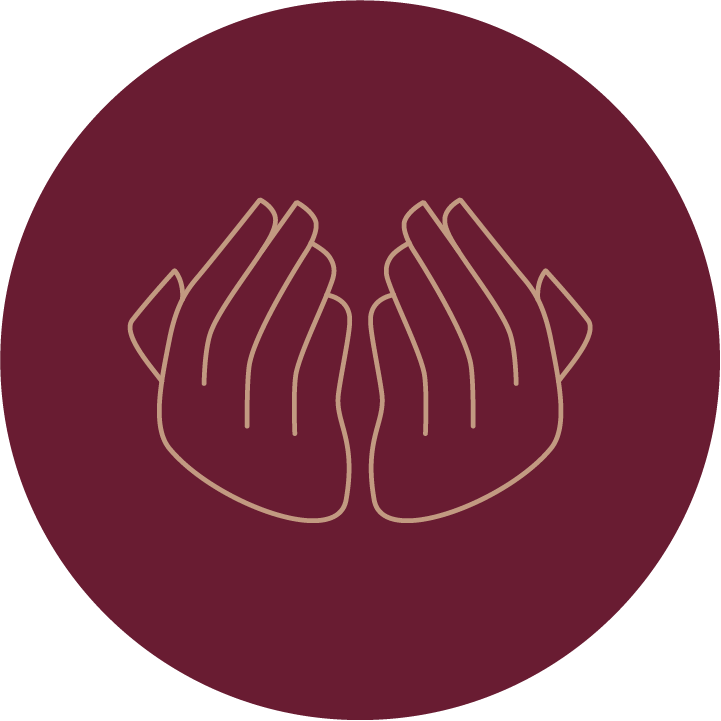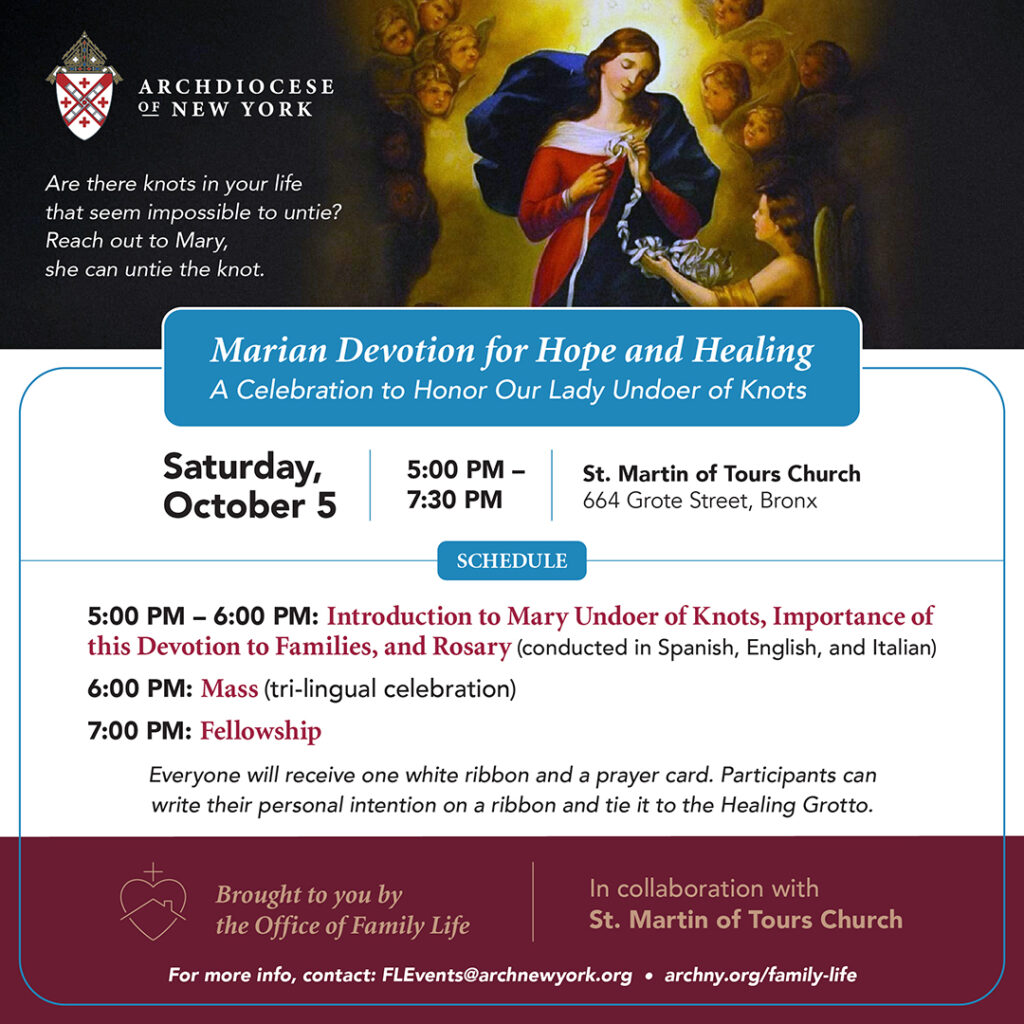
Prayer and Relationship with Christ

Formation

Accompaniment

Advocacy
The family, the home is where faith is learned and grows.
“Love is shown by little things, by attention to small daily signs which make us feel at home. Faith grows when it is lived and shaped by love. That is why our families, our homes, are true domestic churches. They are the right place for faith to become life, and life to grow in faith.” – Pope Francis
Select a topic to be taken to that section of the webpage:
Antipornography
Chastity
Church Documents
Domestic Violence
Fertility Awareness
Marian Devotion for Hope and Healing: A Celebration to Honor Our Lady Undoer of Knots
Are there knots in your life that seem impossible to untie? Reach out to Mary, she can untie the knot.
Everyone will receive one white ribbon and a prayer card. Participants can write their personal intention on a ribbon and tie it to the Healing Grotto. Download the flyer.
Saturday, October 5, 2024
5:00 PM – 7:30 PM
St. Martin of Tours Church
664 Grote Street
Bronx, NY

ANTIPORNOGRAPHY
The following websites provide information, help and guidance on resisting pornography. Please note, they are not affiliated with the Family Life office. We are not responsible for nor do we endorse their policies, views, product or services nor the content of their materials or websites.
- Covenant Eyes: https://www.covenanteyes.com/
Covenant Eyes has crafted resources that specifically address needs for the people in your church. Learn more about this initiative at https://learn.covenanteyes.com/churches/
- Reclaim Sexual Health: https://www.reclaimsexualhealth.com/
- Bought with a Price: https://www.arlingtondiocese.org/Find-Support/Anti-Pornography/
- Catholic Therapist: https://www.catholictherapists.com/
- Fathers for Good: http://www.fathersforgood.org/en/index.html
- Integrity Restored: https://integrityrestored.com/
- Institute for Marital Healing: http://www.maritalhealing.com/
- Theology of the Body: http://www.theologyofthebody.net/
- Covenant Eyes: https://www.covenanteyes.com/
Covenant Eyes has crafted resources that specifically address particular needs for the people in your church. Learn more about this initiative at https://learn.covenanteyes.com/churches/
- The King’s Men: www.thekingsmen.org
- Promise Keepers: www.promisekeepers.org
- Captives Free: https://captivesfree.com/
- Bishops Approve Formal Statement, ‘Create In Me A Clean Heart: A Pastoral Response to Pornography’
- Blessed Are the Pure In Heart. A Pastoral Letter on the Dignity of the Human Person and the Dangers of Pornography by Bishop Finn, Diocese of Kansas
- Bought with a Price by Bishop Loverde, Diocese of Arlington, VA
CHASTITY
If you are a parent or ministry leader looking for helpful resources, programs or continuing education opportunities, Family Honor, Inc., is a national organization that promotes a family-centered Catholic approach to chastity education. Their extensive website offers access to timely articles, research and parent and teen tips on topics relating to chastity, family life, marriage and more, along with information about their parent-child programs, college-level online courses, periodic special events, national conferences and free webinars. You can also sign up for their monthly e-newsletter. For more information, visit Family Honor online or call them at 803-929-0858.
Covenant Eyes
Internet Accountability and Filtering can help you fine-tune your approach to protecting your kids online. Receive reports that show how your kids use the internet to spark good discussions. Choose when and how long kids can be online, block mature websites and create specific lists of sites to be blocked. What we do online impacts our lives offline. Learn more.
Frequently Asked Questions
“The Church calls all to lead “a chaste life in keeping with their particular states in life” (CCC, no 2348), a striving that is performed deliberately, maturely, happily, and for the sake of the Kingdom. It is a surrendering of all genital activity in thought, word, and deed, alone, or with others, hetero-or-homo, honestly confronting any inclinations, drives, or fantasies that threaten the wholesome, healthy, realistic purity mirrored by Jesus and expected by His Church of her people.” –Called To Be Holy by Archbishop Timothy Dolan, Archdiocese of New York (2005).
Nope! All baptized Christians are called to Chastity. (Surprising, isn’t it?) Check it out in the catechism, paragraph 2348.
We are bombarded with messages that tell us what we are saying NO to when we choose to live a chaste life — what we are missing out on. But we’re also saying YES to something: dignity of and the real meaning of love. Click here to discover what you are saying yes to by living a chaste life along with some practical advice on how to live a chaste life now!
Church documents
United States Conference of Catholic Bishops, Called to the Joy of Love: National Pastoral Framework for Marriage and Family Life
Vatican Dicastery of Laity, Family and Life, Catechumenal Pathways for Married Life
Archdiocese of New York/USCCB, Called to the Joy of Love Pastoral Framework
DOMESTIC VIOLENCE
National Domestic Violence Hotline – (1-800-799-SAFE)
Giving Hope to Survivors of Domestic Violence. Counselors are available to take your call through a toll free, 24/7 hotline at 1-800-799-SAFE (7233).
Other resources:
- Loveisrespect | empowering youth to end dating abuse: This site offers articles, quiz and answers to teens’ questions about recognizing and dealing with violence or abuse.
- One Love App: An app that to assess the safety of your relationship, creates a usable action plan, helps women who are facing decisional conflict.
- USCCB – Domestic Violence Page: Offers updated statistics, resources and information about domestic violence. Includes practical suggestions for dioceses and parishes based on actual experiences.
- Domestic violence is any kind of behavior that a person uses to control an intimate partner through fear and intimidation.
- It includes physical, sexual, psychological, verbal and economic abuse.
- Some examples of domestic abuse include battering, name-calling and insults, threats to kill or harm one’s partner or children, destruction of property, marital rape, and forced sterilization or abortion.
According to a U.S. government survey, 53 percent of victims were abused by a current or former girlfriend or boyfriend. One-third of all victims were abused by a spouse, while 14 percent said that the offender was an ex-spouse. Women ages 16 to 24 are nearly three times as vulnerable to attacks by intimate partners as those in other age groups; abuse victims between ages 35 and 49 run the highest risk of being killed.
While abuse cuts across all ethnic and economic backgrounds, some women face particular obstacles. Women of color may not view the criminal justice system as a source of help. Additionally, in some cultures women feel pressured to keep problems within the home and to keep the family together at all costs. Some fear that they will lose face in the community if they leave. Immigrant women often lack familiarity with the language and legal systems of this country. Their abusers may threaten them with deportation.
Women in rural communities may find themselves with fewer resources. The isolation imposed by distance and lack of transportation can aggravate their situation. Isolation can also be a factor for women who do not work outside the home. They may have less access to financial resources and to information about domestic violence. Women with disabilities and elderly women are also particularly vulnerable to violence.
Some who suffer from domestic violence are also victims of stalking, which includes following a person, making harassing phone calls, and vandalizing property. Eight percent of women in the United States have been stalked at some time in their lives, and more than one million are stalked annually. Stalking is a unique crime because stalkers are obsessed with controlling their victims’ actions and feelings. A victim can experience extreme stress, rage, depression, and an inability to trust anyone.
Violence against women in the home has serious repercussions for children. Over 50 percent of men who abuse their wives also beat their children. Children who grow up in violent homes are more likely to develop alcohol and drug addictions and to become abusers themselves. The stage is set for a cycle of violence that may continue from generation to generation.
Domestic violence is often shrouded in silence. People outside the family hesitate to interfere, even when they suspect abuse is occurring. Many times even extended family denies that abuse exists, out of loyalty to the abuser and in order to protect the image of the family. Some people still argue—mistakenly—that intervention by outside sources endangers the sanctity of the home. Yet abuse and assault are no less serious when they occur within a family. Even when domestic violence is reported, sometimes there are failures to protect victims adequately or to punish perpetrators.
One source of healing we have in our lives as Christians is prayer. Psalm 55 may be an especially apt prayer for women who are dealing with abusive situations. With all of you we pray these verses:
Listen, God, to my prayer;
do not hide from my pleading;
hear me and give answer.
If an enemy had reviled me,
that I could bear;
If my foe had viewed me with contempt,
from that I could hide.
But it was you, my other self,
my comrade and friend,
You, whose company I enjoyed,
at whose side I walked
in procession in the house of God.
But I will call upon God,
and the Lord will save me.
At dusk, dawn, and noon
I will grieve and complain,
and my prayer will be heard.
(Ps 55:2-3, 13-15, 17-18)
Religion can be either a resource or a roadblock for battered women. As a resource, it encourages women to resist mistreatment. As a roadblock, its misinterpretation can contribute to the victim’s self-blame and suffering and to the abuser’s rationalizations.
Abused women often say, “I can’t leave this relationship. The Bible says it would be wrong.” Abusive men often say, “The Bible says my wife should be submissive to me.” They take the biblical text and distort it to support their right to batter.
The USCCB bishops, condemn the use of the Bible to support abusive behavior in any form. Violence in any form is sinful. The USCCB bishops have called for a moral revolution to replace a culture of violence. The Catholic Church teaches that violence against another person in any form fails to treat that person as someone worthy of love. Instead, it treats the person as an object to be used. A correct reading of Scripture leads people to an understanding of the equal dignity of men and women and to relationships based on mutuality and love. Beginning with Genesis, Scripture teaches that women and men are created in God’s image. Jesus himself always respected the human dignity of women. Pope John Paul II reminds us that “Christ’s way of acting, the Gospel of his words and deeds, is a consistent protest against whatever offends the dignity of women.”
Men who abuse often use Ephesians 5:22, taken out of context, to justify their behavior, but the passage (v. 21-33) refers to the mutual submission of husband and wife out of love for Christ. Husbands should love their wives as they love their own body, as Christ loves the Church.
Men who batter also cite Scripture to insist that their victims forgive them (see, for example, Mt 6:9-15). A victim then feels guilty if she cannot do so. Forgiveness, however, does not mean forgetting the abuse or pretending that it did not happen. Neither is possible. Forgiveness is not permission to repeat the abuse. Rather, forgiveness means that the victim decides to let go of the experience and move on with greater insight and conviction not to tolerate abuse of any kind again.
An abused woman may see her suffering as just punishment for a past deed for which she feels guilty. She may try to explain suffering by saying that it is “God’s will” or “part of God’s plan for my life” or “God’s way of teaching me a lesson.” This image of a harsh, cruel God runs contrary to the biblical image of a kind, merciful, and loving God. Jesus went out of his way to help suffering women. Think of the woman with the hemorrhage (Mk 5:25-34) or the woman caught in adultery (Jn 8:1-11). God promises to be present to us in our suffering, even when it is unjust.
Finally, the Church emphasizes emphasize that no person is expected to stay in an abusive marriage. Some abused women believe that Church teaching on the permanence of marriage requires them to stay in an abusive relationship. They may hesitate to seek a separation or divorce. They may fear that they cannot re-marry in the Church. Violence and abuse, not divorce, break up a marriage. It is encouraged that encourage abused persons who have divorced to investigate the possibility of seeking an annulment. An annulment, which determines that the marriage bond is not valid, can frequently open the door to healing.
Make your parish a safe place where abused women and men can come for help. Here are some specific suggestions:
- Include information about domestic violence and local resources in parish bulletins and newsletters and on websites.
- Place copies of the USCCB brochure “When I Call For Help” and/or other information, including local telephone numbers for assistance about domestic violence, in the women’s restroom(s).
- Keep an updated list of resources for abused women and men. This can be a project for the parish pastoral council, social justice committee, or group.
- Find a staff person or volunteer who is willing to receive in-depth training on domestic violence; ask this person to serve as a resource and to help educate others about abuse.
- Provide training on domestic violence to all church ministers, including priests, deacons and lay ministers. When possible, provide opportunities for them to hear directly from victims of violence.
- Join in the national observance of October as “Domestic Violence Awareness Month.” Dedicate at least one weekend that month to inform parishioners about domestic abuse. During that month, make available educational and training programs in order to sensitize men and women, girls and boys to the personal and social effects of violence in the family. Help them to see how psychological abuse may escalate over time. Teach them how to communicate without violence.
- Catholics for Family Peace (http://www.catholicsforfamilypeace.org/) offers resources for promoting family peace, including an online training course, “Pastoral Responses to Domestic Violence.”
Use liturgies to draw attention to violence and abuse. Here are some specific suggestions:
- In homilies, include a reference to domestic violence when appropriate. Just a mention of domestic violence lets abused women know that someone cares. Describe what abuse is so that women and men begin to recognize and name what is happening to them.
- In parish reconciliation services, identify violence against women and men as a sin.
- Include intercessions for victims of abuse, people who abuse people, and those who work with them.
- If you suspect abuse, ask direct questions. Ask the her/him if she/he is being hit or hurt at home. Carefully evaluate her/his response. Some people do not realize they are being abused, or they lie to protect their spouses. Be careful not to say anything that will bolster her/his belief that it is her/his fault and that she/he must change her/his behavior.
- Have an action plan in place to follow if an abused person calls on you for help. This includes knowing how and where to refer her/him for help. This will be easier if you have already established contact with local shelters and domestic violence agencies.
- Include a discussion of domestic violence in marriage preparation sessions. If violence has already begun in the relationship, it will only escalate after marriage.
- In baptismal preparation programs, be alert that the arrival of a child and its attendant stress may increase the risk of domestic violence.
FERTILITY AWARENESS
Fertility Awareness, and Fertility Awareness-Based Methods (FABMs) –are the contemporary terms and methods for practicing NFP (Natural Family Planning). We speak more of Fertility Awareness and FABMs which mainstream the goodness of NFP and expand to encompass overall women’s health. These are methods of monitoring and managing women’s health, as well as family planning, in which external and internal signs or biomarkers [that reflect underlying hormonal changes] are combined with an effective set of instructions to help identify times of a woman’s cycle when pregnancy can and cannot occur.
Learn more about Natural Family Planning here.
